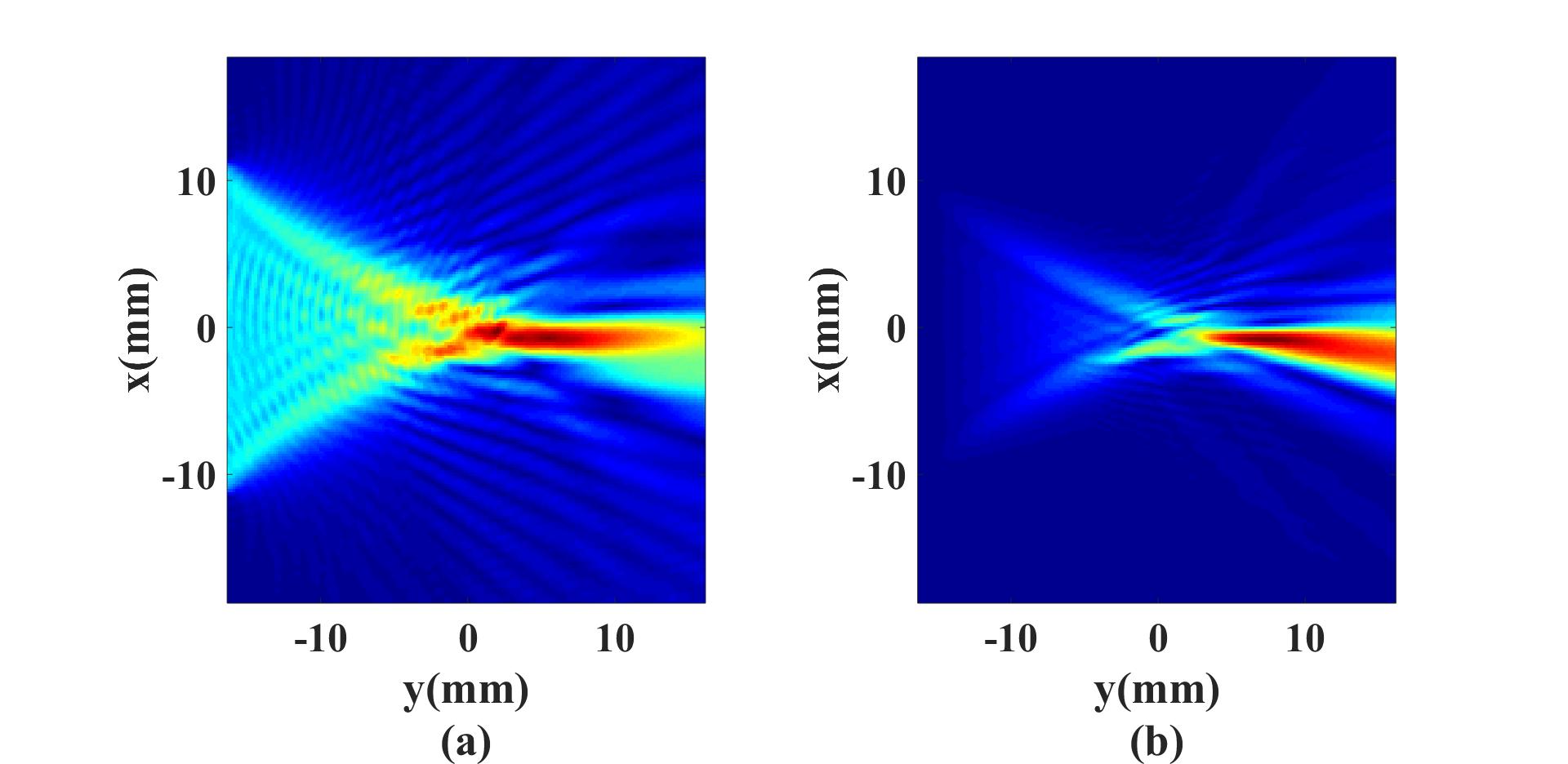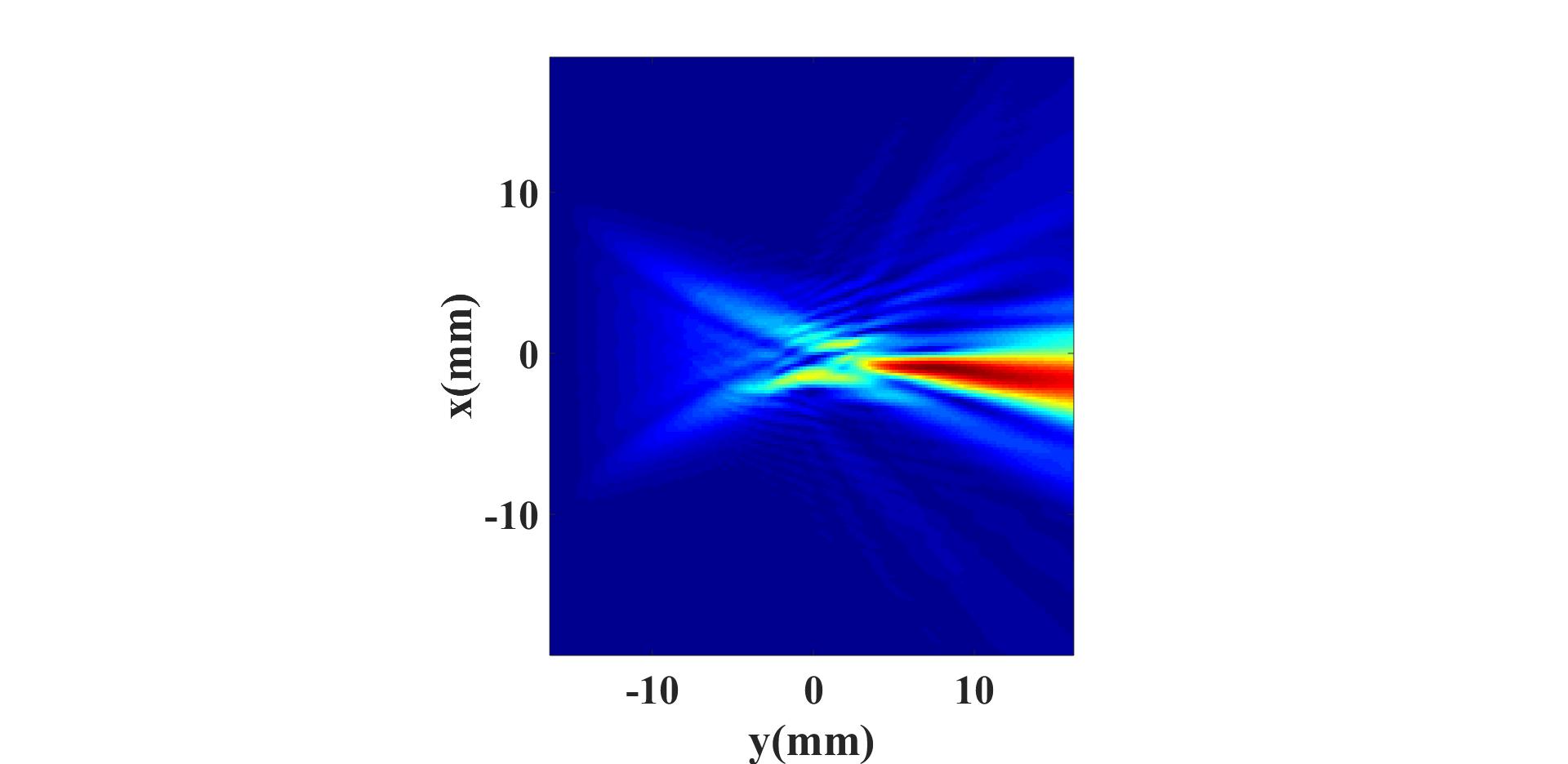Simulation of a 2D heterogeneous medium using the frequency-specific mixed domain method
This example shows how to simulate the frequency-domain wave field in heterogeneous media using the frequency-specific mixed domain method.
Defining the 2D heterogeneous media
Details of defining the computational domain and the phased-array transducer are shown in the example Simulation of a 2D homogeneous medium using the frequency-specific mixed domain method. Medium properties are defined in the example Simulation of a 2D heterogeneous medium using the transient mixed domain method.
2D forward simulation
Assuming linear wave propagation, the center/fundamental frequency pressure field can be calculated with the 2D forward simulation function Forward2D_fund. For weakly nonlinear wave propagation, the pressure field at the second-harmonic frequency can be further calculated with the function Forward2D_sec.The first and second-order reflections are included in the fundamental pressure simulation.
% the maximum order of reflection included in the simulation
reflection_order = 2;
medium.NRL_gamma = 0.5; % constant for absorption layer
medium.NRL_alpha = 0.1; % decay factor for absorption layer
% forward propagation of the fundamental pressure
P_fundamental = Forward2D_fund(mgrid, medium, excit_p, omega_c,...
reflection_order, 'NRL');
% forward propagation of the second-harmonic pressure
P_second = Forward2D_sec(mgrid, medium, P_fundamental, omega_c, 'NRL');
The figure on the left shows the acoustic pressure field at the center/fundamental frequency and the one on the right shows the pressure field at the second-harmonic frequency.

These results can be directly compared with the ones in the example Simulation of a 2D heterogeneous medium using the transient mixed domain method. Two points should be noted here. First, multiple reflection is not considered in the function Forward2D_sec. Second, the density heterogeneity is not automatically considered in the function Forward2D_sec. To include the density heterogeneity, 'correction' must be enabled, and the scattering due to the density variation will be considered in an empirical manner. To include the density heterogeneity in a more accurate way, Forward2D can be used. It is, however, more time-consuming.
% forward propagation of the second-harmonic pressure
P_second = Forward2D_sec(mgrid, medium, P_fundamental, omega_c, 'NRL', 'correction');
The figure below shows the acoustic pressure field at the second-harmonic frequency when 'correction' is enabled in the function Forward2D_sec.

Other examples
·
Simulation of a 2D homogeneous medium using the transient mixed domain method
·
Simulation of a 2D heterogeneous medium using the transient mixed domain method
·
Simulation of a strongly 2D heterogeneous medium using the transient mixed domain method
·
Simulation of a 3D homogeneous medium using the transient mixed domain method
·
Selecting the proper temporal domain size for the TMDM
·
Shock wave simulations with TMDM
·
Simulation of a 2D homogeneous medium using the frequency-specific mixed domain method
·
Simulation of a 2D heterogeneous medium using the frequency-specific mixed domain method
·
Simulation of a 3D homogeneous medium using the frequency-specific mixed domain method
·
Simulation of a 3D heterogeneous medium using the frequency-specific mixed domain method
·
Reducing the spatial aliasing error using the non-reflecting layer
·
Comparing pressure release and rigid boundary conditions
·
Image reconstruction using backward projection
·
Reconstruction of the source pressure distribution with FSMDM in a 3D homogeneous medium
·
Integrating mSOUND with k-Wave for transducers of arbitrary shape
·
Integrating mSOUND with FOCUS for transducers of arbitrary shape
·
Integrating mSOUND with k-Wave for thermal simulations
